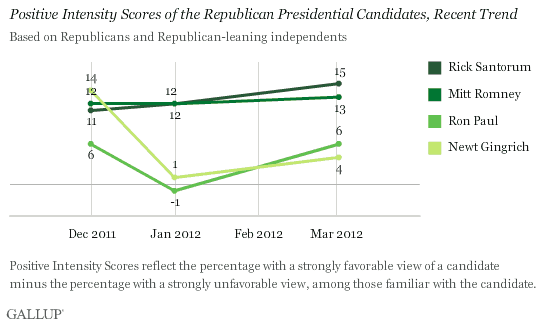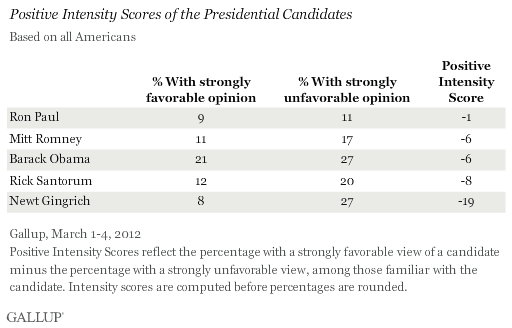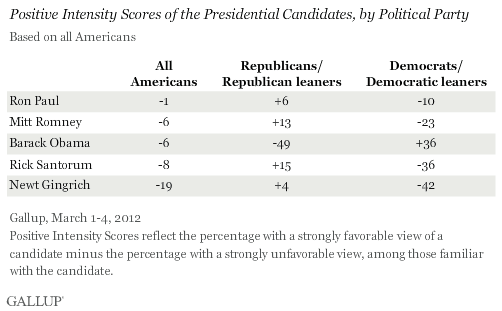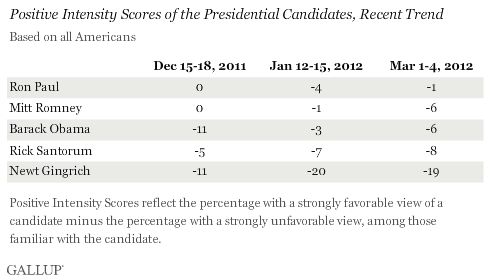PRINCETON, NJ -- Republicans view Rick Santorum and Mitt Romney with roughly equal intensity going into the Super Tuesday primaries. Santorum's Positive Intensity Score of +15 and Romney's of +13 are based on Republicans and Republican-leaning independents familiar with each. The score represents the percentage who have a strongly favorable view of each minus the percentage with a strongly unfavorable view. Ron Paul and Newt Gingrich have lower intensity scores among Republicans.

The results are based on Gallup polling conducted March 1-4, after the Michigan and Arizona primaries and before Tuesday's 10-state schedule. Although the leading GOP contenders are viewed about equally, Romney has gained in Republicans' preferences for the nomination and now leads Santorum by double digits.
Romney's Positive Intensity Score has been stable at +12 or +13 in the three most recent updates. Santorum's has shown modest improvement from +11 to +15, and Gingrich's has declined from +14 to +4. Paul's score has been more variable, due to a lower score in the January update.

Santorum's score has improved as his recognition among Republicans has increased from 58% in December to 87% now. He is now just slightly less known than Romney (95%), Gingrich (93%), and Paul (92%).
Gallup tracked Positive Intensity Scores of Republicans through much of 2011. Despite being among the leading candidates in Republican nomination preferences throughout the campaign, Romney usually was not among the leaders in intensity. At various points since March 2011, the highest Positive Intensity Scores were held by Mike Huckabee (who declined to run), Michele Bachmann, Rick Perry, Herman Cain (including a campaign-high +34), Gingrich, and Santorum. Romney's score topped the list only in the January update, when he tied Santorum at +12.
Democrats Much More Enthusiastic About Obama
Republicans are not highly satisfied with their field of candidates, and the intensity with which they view their candidates pales in comparison to the intensity Democrats have for their candidate. The poll finds Barack Obama's intensity score among Democrats at +36 (42% strongly favorable and 5% strongly unfavorable), more than double the highest score Republicans give any of their candidates.
Despite the differences by party, Americans as a whole view Obama similarly to Romney and Santorum. In the current data, all five major presidential candidates have intensity scores in negative territory, including -6 for Obama and Romney, and -8 for Santorum. Paul has the best score, at -1, though this may be because he generates the least intense feeling in either direction of any candidate, a combined 20% strongly positive and strongly negative opinions. Obama generates the most intense reactions.

The ratings of the candidates by all Americans make it clear the public is more likely to hold strongly negative than strongly positive views of them. This is because Republicans and Democrats tend to hold more strongly negative opinions about politicians from the other party than to hold strongly positive opinions about politicians from their own party. For example, Obama's -49 intensity score among Republicans more than offsets his high +36 among Democrats.

Romney Intensity Among All Americans Down Slightly
Romney's national Positive Intensity Score has changed the most since January, dropping from -1 to -6. Paul's has improved slightly and Obama's has declined slightly, with Santorum's and Gingrich's essentially unchanged.

Romney's decline is mainly due to a drop in Democrats' views of him, from -12 to -23, perhaps because of his status as the leader in the Republican nomination contest and most likely opponent of Obama in the general election. Democrats' opinions of Santorum have also worsened since January, from -28 to -36, while their ratings of Paul and Gingrich have been more stable.
Implications
Romney still does not generate a high degree of intense positive feeling among Republicans, despite his status as the front-runner for the Republican nomination, and he does no better than place second to Santorum in this regard. Both candidates' positive intensity is much less than Democrats have for Obama. However, that could change once the Republican nominee is decided, because the GOP base may rally around its presidential candidate.
Overall, Americans' net strong opinions of each of the leading candidates are similar, though Obama generates both the strongest positive and strongest negative reactions of the presidential candidates -- likely because of his position as the incumbent and his higher profile than that of his would-be challengers.
This is the first year Gallup has measured strongly positive and negative opinions toward presidential candidates, so their predictive ability is unknown. However, in recent elections, Americans have elected the candidate they like better, regardless of intensity.
Survey Methods
Results for this Gallup poll are based on telephone interviews conducted March 1-4, 2012, on the Gallup Daily tracking survey, with a random sample of 2,065 adults, aged 18 and older, living in all 50 U.S. states and the District of Columbia.
For results based on the total sample of 876 Republicans and Republican-leaning independents, one can say with 95% confidence that the maximum margin of sampling error is ±4 percentage points.
For results based on the total sample of 922 Democrats and Democratic-leaning independents, one can say with 95% confidence that the maximum margin of sampling error is ±4 percentage points.
Interviews are conducted with respondents on landline telephones and cellular phones, with interviews conducted in Spanish for respondents who are primarily Spanish-speaking. Each sample includes a minimum quota of 400 cell phone respondents and 600 landline respondents per 1,000 national adults, with additional minimum quotas among landline respondents by region. Landline telephone numbers are chosen at random among listed telephone numbers. Cell phone numbers are selected using random-digit-dial methods. Landline respondents are chosen at random within each household on the basis of which member had the most recent birthday.
Samples are weighted by gender, age, race, Hispanic ethnicity, education, region, adults in the household, and phone status (cell phone only/landline only/both, cell phone mostly, and having an unlisted landline number). Demographic weighting targets are based on the March 2011 Current Population Survey figures for the aged 18 and older non-institutionalized population living in U.S. telephone households. All reported margins of sampling error include the computed design effects for weighting and sample design.
The questions reported here were asked of a random half-sample of respondents for four nights on the Gallup Daily tracking survey.
View methodology, full question results, and trend data.
In addition to sampling error, question wording and practical difficulties in conducting surveys can introduce error or bias into the findings of public opinion polls.
For more details on Gallup's polling methodology, visit www.gallup.com.
